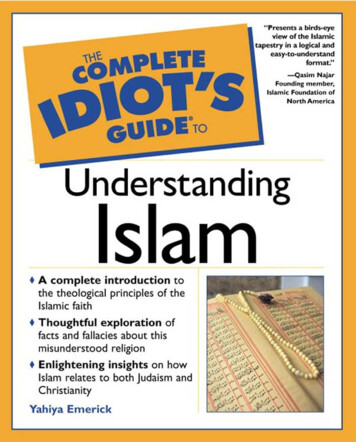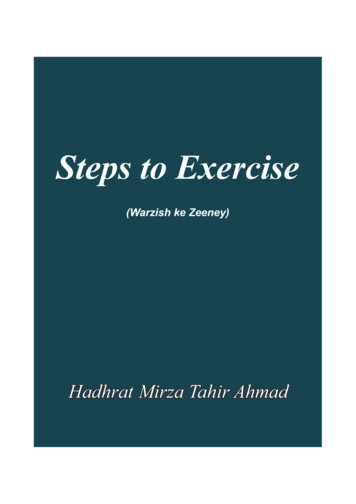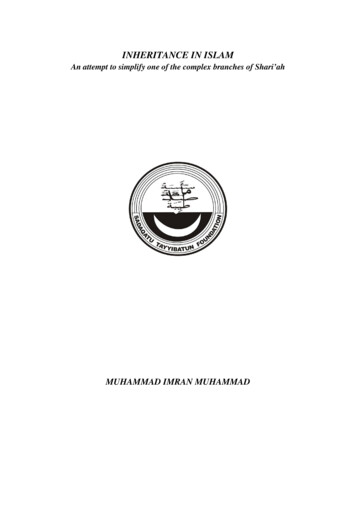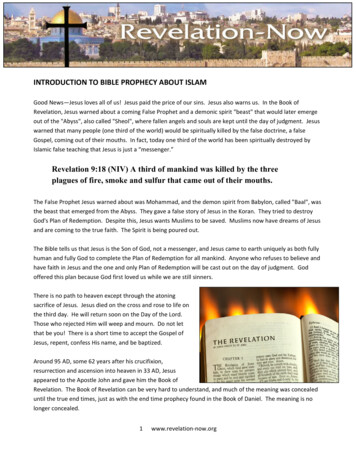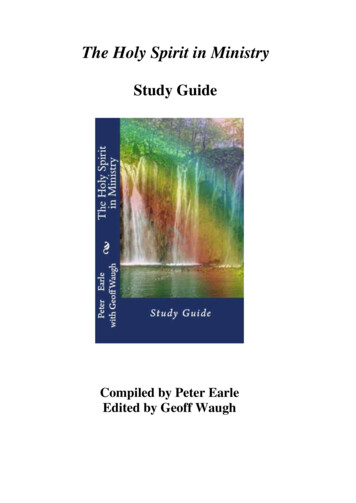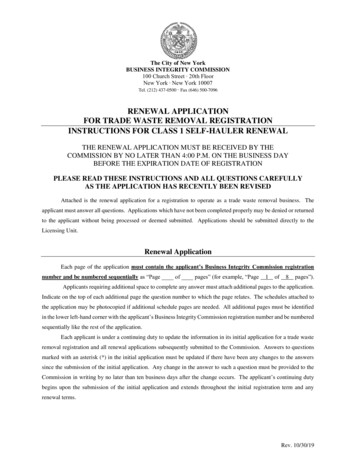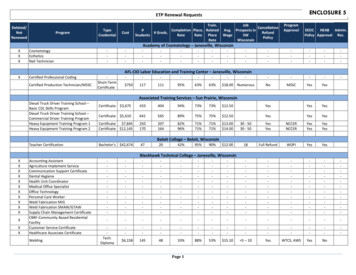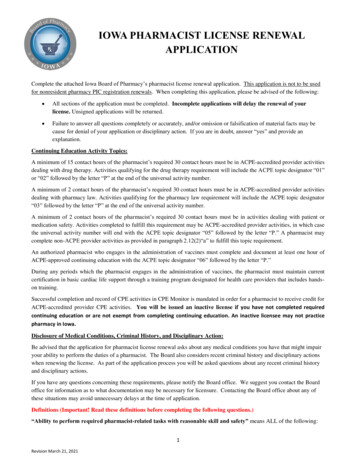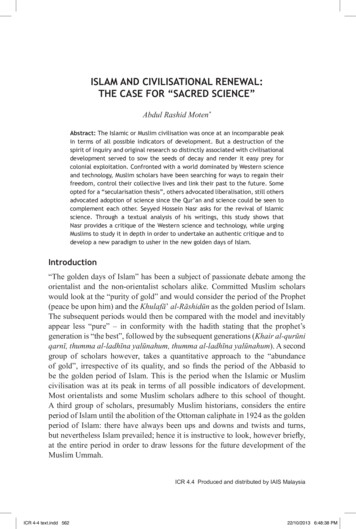
Transcription
ISLAM AND CIVILISATIONAL RENEWAL:THE CASE FOR “SACRED SCIENCE”Abdul Rashid Moten*Abstract: The Islamic or Muslim civilisation was once at an incomparable peakin terms of all possible indicators of development. But a destruction of thespirit of inquiry and original research so distinctly associated with civilisationaldevelopment served to sow the seeds of decay and render it easy prey forcolonial exploitation. Confronted with a world dominated by Western scienceand technology, Muslim scholars have been searching for ways to regain theirfreedom, control their collective lives and link their past to the future. Someopted for a “secularisation thesis”, others advocated liberalisation, still othersadvocated adoption of science since the Qur’an and science could be seen tocomplement each other. Seyyed Hossein Nasr asks for the revival of Islamicscience. Through a textual analysis of his writings, this study shows thatNasr provides a critique of the Western science and technology, while urgingMuslims to study it in depth in order to undertake an authentic critique and todevelop a new paradigm to usher in the new golden days of Islam.Introduction“The golden days of Islam” has been a subject of passionate debate among theorientalist and the non-orientalist scholars alike. Committed Muslim scholarswould look at the “purity of gold” and would consider the period of the Prophet(peace be upon him) and the Khulafā’ al-Rāshidūn as the golden period of Islam.The subsequent periods would then be compared with the model and inevitablyappear less “pure” – in conformity with the hadith stating that the prophet’sgeneration is “the best”, followed by the subsequent generations (Khair al-qurūniqarnī, thumma al-ladhīna yalūnahum, thumma al-ladhīna yalūnahum). A secondgroup of scholars however, takes a quantitative approach to the “abundanceof gold”, irrespective of its quality, and so finds the period of the Abbasid tobe the golden period of Islam. This is the period when the Islamic or Muslimcivilisation was at its peak in terms of all possible indicators of development.Most orientalists and some Muslim scholars adhere to this school of thought.A third group of scholars, presumably Muslim historians, considers the entireperiod of Islam until the abolition of the Ottoman caliphate in 1924 as the goldenperiod of Islam: there have always been ups and downs and twists and turns,but nevertheless Islam prevailed; hence it is instructive to look, however briefly,at the entire period in order to draw lessons for the future development of theMuslim Ummah.ICR 4.4 Produced and distributed by IAIS MalaysiaICR 4-4 text.indd 56222/10/2013 6:48:38 PM
563ABDUL RASHID MOTENIslamic Civilisation: The Golden YearsThe Prophet Muhammad (pbuh) was sent to a nation steeped in barbarism, inthe words of the Qur’an, “to rehearse unto them the signs of Allah, to sanctifythem, to teach them the Scriptures and knowledge – who before had been inutter darkness” (62:2-5). The Prophet, finding the Arabs sunk in degradingand sanguinary superstition, taught them belief in Allah (SWT). Seeing themdisunited, and engaged in perpetual warfare, he united them through ties ofbrotherhood, affinity, and justice. The early spread of Islam was perhaps solelydue to the Prophet’s religious energy and to the firm conviction of his companions.The Prophet brought about a change not only in the religious sphere but also inthe political situation and social conditions. The government established by theProphet was “Shuratic” in nature unlike most of the states and kingdoms of themedieval period; he enunciated a charter of liberty, equality and fraternity inwhich the rights and duties of the Muslims and the non-Muslims were clearlydefined. The intrinsic value of a man was to be judged not by his rank or fortunebut by his character and competence. The government was a constitutional,limited government governed in accordance with the first written constitutionin the world. Al-Khulafā’ al-Rāshidūn simply carried forward the principlesenunciated by the Prophet and followed in his footsteps. This golden age of Islamshowed beyond any reasonable doubt that it is possible to achieve meaningfulsocial restructuring and economic and political development through a politicalsystem that is rooted in ethics and morality.Thus, tawḥīd and its concomitant principles of equality, brotherhood,knowledge, justice, and decision by consultation came to play an important rolein the history of mankind. Its stage was the globe; its time was for all ages tocome, and its dramatis personae a multitude of the people of mankind. WhileChristendom passed through an age of comparative darkness, a vigorous periodof intellectual growth in places like Baghdad, Damascus, and Toledo was underway. From the 9th to the 11th century, the most mighty and active civilisation ofthe world was Islamic. Hispano-Arab Spain gave the world versatile and worldfamed philosophers, astronomers, mathematicians, mystics and historians. Itwas a period of intellectual enlightenment and material prosperity and of theterritorial expansion of Islamic civilisation.Decline and decay becomes imminent for those civilisations which, afterreaching the zenith of glory, set aside the basic principles of human values andfreedom to rule the people at the point of the sword devoid of regard for truthand justice. Decline certainly sets in when a country becomes a dwelling forpolitical fanaticism, wholesale corruption and moral turpitude. It surely fallsupon the people when their leaders turn into demagogues and opportunists bentISLAM AND CIVILISATIONAL RENEWALICR 4-4 text.indd 56322/10/2013 6:48:38 PM
ISLAM AND CIVILISATIONAL RENEWAL: THE CASE FOR “SACRED SCIENCE”564upon destroying their competitors in partisan bickering, squabbles and intrigues.History clearly testifies that the civilisations of Babylon and Abbasids were lostin the wealth of legend, because these empires were ruled with ruthless crueltyand wanton oppression. Baghdad, the seat of learning and knowledge and cradleof Islamic civilisation, was crowded with ambitious leaders of Machiavelliandexterity who manoeuvred to retain power. It was consequently brought downby the Mongols. The sack of Baghdad brought about the reckless assassinationof thousands of scholars, poets, and writers and the destruction of librariesand colleges, bringing irreparable disaster to Muslim civilisation. With theextermination of men of learning and the destruction of Muslim society, the spiritof inquiry and original research so distinctly associated with Islam’s civilisationaldevelopment was practically destroyed.Muslims have been searching and writing ceaselessly for ways to break outof this situation, to regain control of their collective lives and to link their pastto the future. Some scholars, subscribing to the “secularisation thesis”, suggesta Western-style secular state and argue that in course of time religion willdisappear (Bell, 1977:306; Breen & Hayes, 1996; Hadden, 1987). But religion, totheir dismay, has not merely survived but, in fact has blossomed (Bouma, 2008;Thomas, 2005). It continues to play a dominant role at national and internationallevels (May, 2008) as exemplified by the rise of new religious movements andspiritualities (Hunter, 1981; Marty & Appleby, 1991-c.1995). There are otherswho advocate a Sharīʿah-governed society, but who cannot agree upon themodel to be implemented. Finally, there are others who seek a synthesis of Islam,nationalism, democracy and modern technical capabilities. Some of these writingsreflect biased scholarship, as is generally the case with “Orientalism”. Muslimapologists deny the allegations and challenge the malevolent representations ofMuslim ideals and aspirations. Some other writings by Muslims are characterisedby obduracy and are closed to new methods of critical enquiry.There also has emerged a group of scholars who seek to engage with theWest directly. They proceed from the standpoint that knowledge acquired anddisseminated by the West throughout the world was exploitative and aimed atestablishing and sustaining Western economic and political control. They argue,however, not to forsake science and education but to pursue it in an “Islamic”way, so as to promote civilisational renewal. This movement is referred to as the“Islamisation of knowledge” project and it has taken many forms. One groupof scholars put all their efforts into identifying modern scientific knowledgefrom the revealed sources, specifically from the Qur’an. A second group ofscholars highlight the scientific achievements of the earlier Muslim scholarsduring the golden days of Islam. Their aim is to highlight the failure of the Westto acknowledge the role Muslim scientific achievements played in the rise ofICR 4.4 Produced and distributed by IAIS MalaysiaICR 4-4 text.indd 56422/10/2013 6:48:38 PM
565ABDUL RASHID MOTENWestern civilisation. They also aim at educating the Muslims about their past andto follow their predecessors in charting a better future.Finally, a third grouping, and the main focus of this paper, proposes aproject which aims at rediscovering and pursuing what is known as the “SacredScience” or “Religious Science”. Seyyed Hossein Nasr has emphasised in all hiswritings on the necessity of recovering “Religious and Sacred Science” from thetraditionalist point of view. After a brief introduction to the “living philosopher”,this paper describes Nasr’s critique of modernism and modern science and theresponses modernism has generated, examines the traditional science, whichNasr fervently aspires to revive, and provides a critique of Nasr’s position.Seyyed Hossein NasrSeyyed Hossein Nasr, an Ismāʿīlī Shīʿite and gnostic thinker, was born on April7, 1933 in south-central Tehran to an educated family. He received his earlyeducation in Tehran where he learnt religion, poetry and classical literature. Nasrwent to study physics and mathematics at the prestigious Massachusetts Instituteof Technology (MIT) and obtained his B.S. in 1954 with honours. Thereafter,he started to study geology and geophysics at Harvard, but he soon changed thecourse of his academic studies opting instead to study the history of science andphilosophy. Nasr obtained his doctorate in 1958 with specialisation in cosmologyand Islamic sciences. His doctoral dissertation was on conceptions of Naturein Islamic thought which was later published under the title An Introductionto Islamic Cosmological Doctrines (1964). During his studies, Nasr becamefamiliar with the writings of F. Schuon and Henry Corbin and was greatlyinfluenced by them. He first served at Tehran University as a professor of historyof science and philosophy and also served as a visiting professor at Harvard andother Universities. In 1975, Nasr and Corbin founded the Imperial Academy ofPhilosophy with the blessings of Empress Farah of Iran. In 1979, Nasr migratedto the United States and taught at several American universities before finallyjoining the George Washington University, Washington DC in 1984 as theUniversity Professor of Islamic Studies. Nasr is the first Muslim to deliver theprestigious Glifford Lectures at the University of Edinburgh, later published asKnowledge and the Sacred (1981). He is also the recipient of the TempletonReligion and Science Course Award and the only Muslim scholar to have beenrecognised as a living philosopher through the publication of a volume on Nasrin the Library of Living Philosophers Series (Hahn, Auxier and Stone, 2001).Seyyed Hossein Nasr speaks and writes from the standpoint of the doctrineand viewpoints of “the philosophia perennis” (perennial philosophy) which isrooted in the metaphysical and the sacred and which, he believes, is valid for allpeople regardless of time and place since it deals with universal principles. HeISLAM AND CIVILISATIONAL RENEWALICR 4-4 text.indd 56522/10/2013 6:48:38 PM
ISLAM AND CIVILISATIONAL RENEWAL: THE CASE FOR “SACRED SCIENCE”566has argued for the revival of religious values, spirituality and “tradition.” Most ofhis ideas are derived from the scholarship of Rene Guenon and Fritjof Schuon.He is considered to beOne of the leading figures in the “neo-traditionist” movement in modern Islam and hascontributed enormously to the enrichment of ideas earlier propounded by Rene Guenon.[Moreover] his defense of the “whole and integral tradition of Islam” separates him fromother contemporary Shi’ite Muslim thinkers and brings him closer to the mainstream ofIslamic thought (Nyang and Ahmad, 1985: 289)He has written extensively on a variety of subjects including philosophy, religion,spirituality, science and the natural environment. Seyyed Hossein Nasr is aprolific author. The fifty-odd books and monographs and 500 articles producedduring 1961 to 1999 can be divided into two broad fields – Islamic studies andthe philosophia perennis (Chittick, 2007: ix-xiv). His Science and Civilizationin Islam (1968) is praised for clarifying the concept of “Islamic science” andfor highlighting the achievements of Islamic scientific tradition in such fieldsas medicine, astronomy, mathematics, physics, geography, and natural history.Another famous work is his Islamic Science: An Illustrated Study (1976), whichdefines Islamic science, its philosophical premises, its history and developmentwith clarity. Nasr’s analysis of the relationship between Islam and science is foundin many of his writings including Islamic Life and Thought (1981), The YoungMuslim’s Guide to the Modern World (1993), and The Islamic Intellectual Historyin Persia (1994). Nasr has been accorded the highest honour of the academicworld in the dedication of a volume of The Library of Living Philosophers tohis work and thought (Hahn, 2001). Nasr is an eloquent speaker and a highlyrespected intellectual figure in the Western philosophical world.Modern ScienceSeyyed Hossein Nasr is specifically concerned with modern science and itsimplications for humanity. I
ISLAM AND CIVILISATIONAL RENEWAL: THE CASE FOR “SACRED SCIENCE” ICR 4-4 text.indd 564 22/10/2013 6:48:38 PM. 565 ISLAM AND CIVILISATIONAL RENEWAL Western civilisation. They also aim at educating the Muslims about their past and to follow their predecessors in charting a better future. Finally, a third grouping, and the main focus of this paper, proposes a project which aims at .
